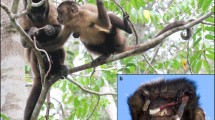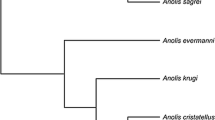Abstract
Predatory snakes are argued to have been largely responsible for the origin of primates via selection favoring expansion of the primate visual system, and even today snakes can be deadly to primates. Neurobiological research is now beginning to reveal the mechanisms underlying the ability of primates (including humans) to detect snakes more rapidly than other stimuli. However, the visual cues allowing rapid detection of snakes, and the cognitive and ecological conditions contributing to faster detection, are unclear. Since snakes are often partially obscured by vegetation, the more salient cues are predicted to occur in small units. Here we tested for the salience of snake scales as the smallest of potential visual cues by presenting four groups of wild vervet monkeys (Chlorocebus pytherythrus) with a gopher snake (Pituophis catenifer) skin occluded except for no more than 2.7 cm, in natural form and flat, the latter to control for even small curvilinear cues from their unusual body shape. Each of these treatments was preceded by a treatment without the snakeskin, the first to provide a baseline, and the second, to test for vigilance and memory recall after exposure to the snakeskin. We found that (1) vervets needed only a small portion of snakeskin for detection, (2) snake scales alone were sufficient for detection, (3) latency to detect the snakeskin was longer with more extensive and complex ground cover, and (4) vervets that were exposed to the snakeskin remembered where they last saw “snakes”, as indicated by increased wariness near the occluding landmarks in the absence of the snakeskin and more rapid detection of the next presented snakeskin. Unexpectedly, adult males did not detect the snakeskin as well as adult females and juveniles. These findings extend our knowledge of the complex ecological and evolutionary relationships between snakes and primates.




Similar content being viewed by others
References
Almeida I, Soares SC, Castelo-Branco M (2015) The distinct role of the amygdala, superior colliculus and pulvinar in processing of central and peripheral snakes. PLoS One 10:e0129949. doi:10.1371/journal.pone.0129949
Arnold SJ, Bennett AF (1984) Behavioral variation in natural populations III: antipredator displays in the garter snake Thamnophis radix. Anim Behav 32:1108–1118
Carter AJ, Marshall HH, Heinsohn R, Cowlishaw G (2012) How not to measure boldness: novel object and antipredator responses are not the same in wild baboons. Anim Behav 84:603–609
Coss RG (2003) The role of evolved perceptual biases in art and design. In: Voland E, Grammer K (eds) Evolutionary aesthetics. Springer, Heidelberg, pp 69–130
Fisch L, Privman E, Ramot M, Harel M, Nir Y, Kipervasser S, Andelman F, Neufeld MY, Kramer U, Fried I, Malach R (2009) Neural ignition: enhanced activation linked to perceptual awareness in human ventral stream visual cortex. Neuron 64:562–574
Goel N, Bale TL (2008) Organizational and activational effects of testosterone on masculinization of female physiological and behavioral stress responses. Endocrinology 149:6399–6405
Greene HW (1997) Snakes: the evolution of mystery in nature. University of California Press, Berkeley
Handa RJ, McGivern RF (2015) Steroid hormones, receptors, and perceptual and cognitive sex differences in the visual system. Curr Eye Res 40:110–127
Hankerson SJ, Caine NG (2004) Pre-retirement predator encounters alter the morning behavior of captive marmosets (Callithrix geoffroyi). Am J Primatol 63:75–85
Hayakawa S, Kawai N, Masataka N (2011) The influence of color on snake detection in visual search in human children. Sci Rep 1:80. doi:10.1038/srep00080
He H, Kubo K, Kawai N (2014) Spiders do not evoke greater early posterior negativity in the event-related potential as snakes. Neuroreport 25:1049–1053
Headland TN, Greene HW (2011) Hunter–gatherers and other primates as prey, predators, and competitors of snakes. Proc Natl Acad Sci 108:E1470–E1474
Isbell LA (2006) Snakes as agents of evolutionary change in primate brains. J Hum Evol 51:1–35
Isbell LA (2009) The fruit, the tree, and the serpent: why we see so well. Harvard University Press, New York
Jacobs GH (2009) Evolution of colour vision in mammals. Philos Trans R Soc B 364:2957–2967
Kardong KV, Bels VL (1998) Rattlesnake strike behavior: kinematics. J Exp Biol 201:837–850
Kastner S, O’Connor DH, Fukui MM, Fehd HM, Herwig U, Pinsk MA (2004) Functional imaging of the human lateral geniculate nucleus and pulvinar. J Neurophysiol 91:438–448
Kawai N, Koda H (2016) Japanese monkeys (Macaca fuscata) quickly detect snakes but not spiders: evolutionary origins of fear-relevant animals. J Comp Psychol. doi:10.1037/com0000032
Kirk EC, Kay RF (2004) The evolution of high visual acuity in the Anthropoidea. In: Ross C, Kay RF (eds) Anthropoid origins: new visions. Kluwer Academic/Plenum Press, New York, pp 539–602
Le QV, Isbell LA, Nguyen MN, Matsumoto J, Hori E, Maior RS, Tomaz C, Tran AH, Ono T, Nishijo H (2013) Pulvinar neurons reveal neurobiological evidence of past selection for rapid detection of snakes. Proc Natl Acad Sci 110:19000–19005
Le QV, Isbell LA, Matsumoto J, Quang LV, Hori E, Tran AH, Maior RS, Tomaz C, Ono T, Nishijo H (2014) Monkey pulvinar neurons fire differentially to snake postures. PLoS One 9:e114258. doi:10.1371/journal.pone.0114258
Le QV, Isbell LA, Matsumoto J, Le VQ, Nishimaru H, Hori E, Maior RS, Tomaz C, Ono T, Nishijo H (2016) Snakes elicit earlier, and monkey faces, later, gamma oscillations in macaque pulvinar neurons. Sci Rep 6:20595. doi:10.1038/srep20595
LoBue V, DeLoache JS (2010) Superior detection of threat-relevant stimuli in infancy. Dev Sci 13:221–228
LoBue V, DeLoache JS (2011) What’s so special about slithering serpents? Children and adults rapidly detect snakes based on their simple features. Vis Cogn 19:129–143
LoBue V, Rakison DH, DeLoache JS (2010) Threat perception across the life span: evidence for multiple converging pathways. Curr Dir Psychol Sci 19:375–379
Masataka N, Shibasaki M (2012) Premenstrual enhancement of snake detection in visual search in healthy women. Sci Rep 2:307. doi:10.1038/srep00307
Masataka N, Hayakawa S, Kawai N (2010) Human young children as well as adults demonstrate superior rapid snake detection when typical striking posture is displayed by the snake. PLoS One 5:e15122. doi:10.1371/journal.pone.0015122
McGrew WC (2015) Snakes as hazards: modeling risk by chasing chimpanzees. Primates 56:107–111
Meno W, Coss RG, Perry S (2013) Development of snake-directed antipredator behavior by wild white-faced capuchin monkeys: I. Snake-species discrimination. Am J Primatol 75:281–291
Öhman A (2009) Of snakes and faces: an evolutionary perspective on the psychology of fear. Scand J Psychol 50:543–552
Öhman A, Flykt A, Esteves F (2001) Emotion drives attention: detecting the snake in the grass. J Exp Psychol Gen 130:466–478
Öhman A, Soares SC, Juth P, Lindström B, Esteves F (2012) Evolutionary derived modulations of attention to two common fear stimuli: serpents and hostile humans. J Cogn Psychol 24:17–32
Okusa T, Kakigi R, Osaka N (2000) Cortical activity related to cue-invariant shape perception in humans. Neuroscience 98:615–624
Palanza P (2001) Animal models of anxiety and depression: how are females different? Neurosci Biobehav Rev 25:219–233
Penkunas MJ, Coss RG (2013a) Rapid detection of visually provocative animals by preschool children and adults. J Exp Child Psychol 114:522–536
Penkunas MJ, Coss RG (2013b) A comparison or rural and urban Indian children’s visual detection of threatening and nonthreatening animals. Dev Sci 2013:1–13. doi:10.1111/desc.12043
Penning DA, Sawvel B, Moon BR (2016) Debunking the viper’s strike: harmless snakes kill a common assumption. Biol Lett 12:20160011. doi:10.1098/rsbl.2016.0011
Ross CF (2000) Into the light: the origin of Anthropoidea. Ann Rev Anthropol 29:147–194
Schupp HT, Junghöfer M, Weike AI, Hamm AO (2003) Emotional facilitation of sensory processing in the visual cortex. Psychol Sci 14:7–13
Schupp HT, Flaisch T, Stockburger J, Junghöfer M (2006) Emotion and attention: event-related brain potential studies. Prog Brain Res 156:31–51
Seyfarth RM, Cheney DL, Marler P (1980) Vervet monkey alarm calls: semantic communication in a free-ranging primate. Anim Behav 28:1070–1094
Shibasaki M, Kawai N (2009) Rapid detection of snakes by Japanese monkeys (Macaca fuscata): an evolutionarily predisposed visual system. J Comp Psychol 123:131–135
Soares SC (2012) The lurking snake in the grass: interference of snake stimuli in visually taxing conditions. Evol Psychol 10:187–197
Soares SC, Esteves F (2013) A glimpse of fear: Fast detection of threatening targets in visual search with brief stimulus durations. PsyCh J 2:11–16. doi:10.1002/pchj.18
Soares SC, Lindström B, Esteves F, Öhman A (2014) The hidden snake in the grass: superior detection of snakes in challenging attentional conditions. PLoS One 9:e114724. doi:10.1371/journal.pone.0114724
Starin ED, Burghardt GM (1992) African rock pythons (Python sebae) in the Gambia: observations on natural history and interactions with primates. Snake 24:50–62
Struhsaker TT (1967) Auditory communication among vervet monkeys (Cercopithecus aethiops). In: Altmann SA (ed) Social communication among primates. University of Chicago Press, Chicago, pp 281–324
Thrasher C, LoBue V (2016) Do infants find snakes aversive? Infants physiological responses to fear-relevant stimuli. J Exp Child Psychol 142:382–390
van Schaik CP, Mitrasetia T (1990) Changes in the behaviour of wild long-tailed macaques (Macaca fascicularis) after encounters with a model python. Folia Primatol 55:104–108
van Strien JW, Eijlers R, Huijding FJ (2014a) Snake pictures draw more early attention than spider pictures in non-phobic women: evidence from event-related brain potentials. Biol Psychol 96:150–157
van Strien JW, Franken IHA, Huijding J (2014b) Testing the snake-detection hypothesis: larger early posterior negativity in humans to pictures of snakes than to pictures of other reptiles, spiders and slugs. Front Hum Neurosci 8:691. doi:10.3389/fnhum.2014.00691
van Strien JW, Christiaans G, Franken IHA, Huijding J (2016) Curvilinear shapes and the snake detection hypothesis: an ERP study. Psychophysiology 53:252–357
Villeneuve MY, Kupers R, Gjedde A, Ptito M, Casanova C (2005) Pattern–motion selectivity in the human pulvinar. Neuroimage 28:474–480
Whitaker PB, Ellis K, Shine R (2000) The defensive strike of the Eastern Brownsnake, Pseudonaja textilis (Elapidae). Funct Ecol 14:25–31
Wombolt JR, Caine NG (2016) Patterns on serpentine shapes elicit visual attention in marmosets (Callithrix jacchus). Am J Primatol. doi:10.1002/ajp.22563
Wüster W, Broadley DG (2007) Get an eyeful of this: a new species of giant spitting cobra from eastern and north-eastern Africa (Squamata: Serpentes: Elapidae: Naja). Zootaxa 1532:51–68
Yorzinski JL, Penkunas MJ, Platt ML, Coss RG (2014) Dangerous animals capture and maintain attention in humans. Evol Psychol 12:534–548
Young BA (2010) How a heavy-bodied snake strikes quickly: high-power axial musculature in the puff adder (Bitis arietans). J Exp Zool Part A: Ecol Genet Physiol 313:114–121
Acknowledgments
This research was supported by the National Science Foundation (BCS 99-03949 and BCS 1266389) and was conducted under local affiliation with the Kenya Wildlife Service and with permission to conduct research in Kenya from NACOSTI (permit no. NACOSTI/P/I5/5820/4650). The study has IACUC approval (protocol no. 19172) from the University of California, Davis. We are grateful to Margaret Kinnaird, Dino Martins, the staff at Mpala Research Centre, and Truman Young for logistical support, Wilson Longor for help in identifying the HP individuals, Jessica Alvarez, David Madry, Chyna Oyola, and Mariel Viano for scoring the videos, Brianne Beisner, Richard Coss, Harry Greene, and Truman Young for helpful discussions and comments on earlier drafts, two anonymous reviewers for their insightful comments, and, of course, the monkeys.
Author information
Authors and Affiliations
Corresponding author
About this article
Cite this article
Isbell, L.A., Etting, S.F. Scales drive detection, attention, and memory of snakes in wild vervet monkeys (Chlorocebus pygerythrus). Primates 58, 121–129 (2017). https://doi.org/10.1007/s10329-016-0562-y
Received:
Accepted:
Published:
Issue Date:
DOI: https://doi.org/10.1007/s10329-016-0562-y




